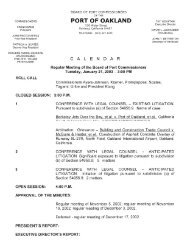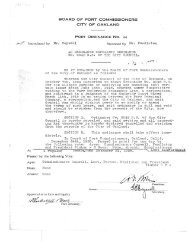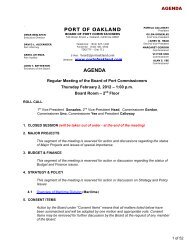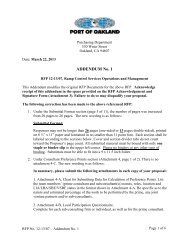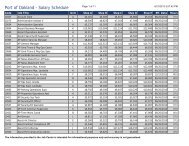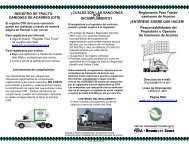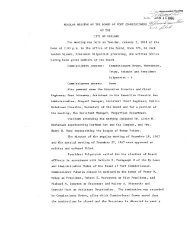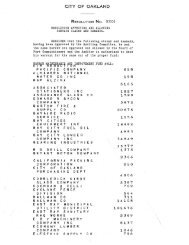Port-Wide Sewer System Management Plan(SSMP) - Port of Oakland
Port-Wide Sewer System Management Plan(SSMP) - Port of Oakland
Port-Wide Sewer System Management Plan(SSMP) - Port of Oakland
You also want an ePaper? Increase the reach of your titles
YUMPU automatically turns print PDFs into web optimized ePapers that Google loves.
There is a significant I/I response throughout the <strong>Port</strong>’s wastewater collection system, which<br />
leads to design flow peaking factors greater than the industry standard in most locations. In<br />
general, though, the majority <strong>of</strong> sewers in the <strong>Port</strong> are currently sized with sufficient<br />
capacity to convey existing design flows. This assumes, however, that the existing sewers<br />
are free <strong>of</strong> sediment buildup, fats, oil, and grease (FOG) build up, large debris, and other<br />
capacity limiting materials. Excessive build up in a sewer will restrict flow, which can lead to<br />
sewer backups and SSOs in severe cases.<br />
9.2.5 Capacity Enhancement Measures<br />
Figure 9.1 illustrates the proposed sewer improvements required to correct existing<br />
deficiencies and to accommodate future growth in the <strong>Port</strong>. This section summarizes the<br />
projects shown on Figure 9.1, while Table 9.3 contains specific details related to each<br />
project.<br />
9.2.5.1<br />
The majority <strong>of</strong> sewers within the <strong>Port</strong> contain sufficient capacity to accommodate existing<br />
and future design flows without exceeding the established capacity criteria. There are a few<br />
exceptions where existing sewers will need to be replaced by larger diameter sewers, or<br />
parallel sewers will need to be constructed to bypass flow around hydraulically deficient<br />
sewers. The decision as to whether a particular sewer should be replaced or a parallel<br />
sewer constructed should be made during the preliminary design phase. This study<br />
assumes that deficient sewers will be replaced.<br />
9.2.5.2<br />
Pipeline Capacity Improvements<br />
Lift Station Replacement or Rehabilitation<br />
Visual inspection <strong>of</strong> the <strong>Port</strong>’s sanitary sewer lift stations was performed on March 5 and 6,<br />
2010 as part <strong>of</strong> this study. More detail is provided in Appendix M.<br />
Lift station replacement or rehabilitation will be necessary to maintain proper operation <strong>of</strong><br />
existing facilities and to meet the requirements <strong>of</strong> the Environmental Protection Agency’s<br />
(EPA’s) Administrative Order. Therefore, we assumed that each lift station in the <strong>Port</strong> would<br />
be rehabilitated or replaced by the year 2030 and beyond. The rehabilitation and<br />
replacement projects were phased considering the findings <strong>of</strong> the visual inspections such<br />
that the costs associated with these projects were distributed as evenly as possible through<br />
year 2030 and beyond. Required capacities for each lift station are identified for each lift<br />
station in Table 9.3, based on the requirement that each lift station be equipped with<br />
sufficient firm capacity to pump the design flow.<br />
May 2010 9-6<br />
pw://Carollo/Documents/Client/CA/<strong>Port</strong> <strong>of</strong> <strong>Oakland</strong>/8239A00/Deliverables/Ch09 (FinalA)



